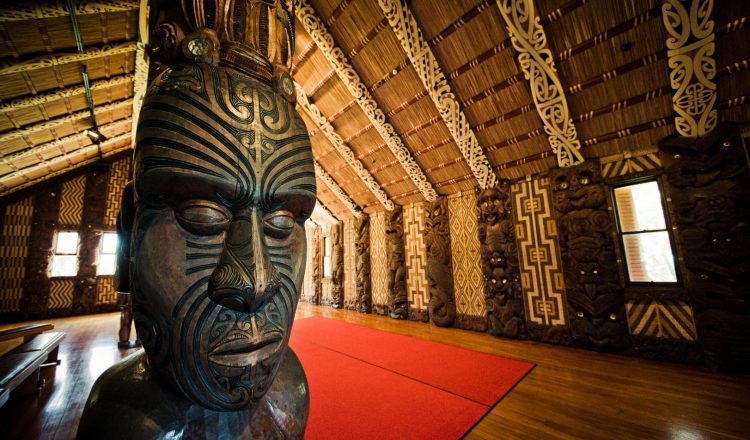マオリの芸能
芸能と創造性は神々の乗り物であるという深い信念を持つマオリ族の芸能と工芸品は、彼らの文化の神聖な部分であり、世界中で認識されているマオリ族の生活の数少ない側面のひとつです。マオリ族は、過去は未来であり、現在はループしていると考えています。そのため、多くの伝統芸能は、できるだけ先祖伝来の技術に近づけようとします。芸術の神聖さは、その創造だけでなく、世代を超えて受け継がれていくことにもあります。
Pounamu (グリーンストーン)
ポウナム(Pounamu, グリーンストーンの意)は耐久性のある硬い石で、マオリ文化の中で大切にされてきました。伝統的にグリーンストーンには、ネフライト・ジェイド、ボーエナイト、サーペンタイトなどがありましたが、現在ではネフライト・ジェイドが主流となっています。マオリの人々は、ポウナムをマオリの神聖な宝物であるタオンガ(taonga)と考えています。そのため、グリーンストーンが採れる地域は、通常、政府の法律で保護されており、地元のイウィがその流通を管理しています。
マオリ族はポウナムを道具や装飾品に使っていました。道具が古くなって使えなくなると、石を宝飾品類に転用しました。グリーンストーンを持っていると、マオリの社会では名声が高まると考えられていましたが、自分で買ったり、彫ったりすると不運を招くと言われています。グリーンストーンのネックレスやジュエリーは、今でも世界的に人気があります。ディズニーは、映画『モアナと伝説の海(Moana)』の中で、グリーンストーンの重要性を言及しました。
Whakairo (彫刻)
マオリ族にとって、Whakairo(彫刻)の技術は、今でも日常生活に欠かせないものです。伝統的に木、石、骨、そしてグリーンストーンが彫刻に使われてきました。彫りのスタイルは各イウィによって異なりますが、whakairoは自然や使用する素材から影響を受けます。木はマオリ族が最もよく使う彫刻素材で、彼らは伝統的にwaka(カヌー)の製作に地元の木材を使っていました。木彫りは、現代のマオリ文化においても、マラエの装飾に使われるなど、重要な役割を果たしています。ボーンカービング(骨の彫刻)には鯨の骨が使われ、釣り針などの複雑な道具や装飾品が作られました。
マオリの彫刻には、通常、人間の体や、守護者としての役割を果たす鳥頭の蛇であるマナイアが描かれています。whakairoの技術は非常にスピリチュアルなものであり、現在も受け継がれています。
Raranga(織物)
マオリの織物、ラランガ(Raranga)は、単に服や衣服を作るだけのものではありません。それは、アーティストを通して神々からのメッセージを伝える行為です。これは何世代にもわたって受け継がれてきた神聖な芸術であり、ニュージーランドでは今でも個人や大学レベルで教えられています。
亜麻はよく選ばれる素材で、織り手は美しい複雑な服やバスケット、壁掛けなどを作ります。マオリ族の人々は、伝統的な織りの技術で作られた服を儀式の際に着用します。演者は自分の名声を高めたり、伝統の一部を宣言するためにそれらを身につけます。マオリ族の織物は、通常、黒、白、金などの自然の色を使用しますが、現代では、製品を向上させるために染料を使用することもあります。
Ta Moko(タトゥー)
タ・モコ(Ta Moko)は、マオリ文化におけるタトゥーの伝統であると言っても過言ではありません。タトゥーをする人にとっては、とても特別な行為なのです。マオリのタトゥーは、他のポリネシアの部族のデザインに似ていますが、単に美的な目的を果たすだけではありません。顔や体に彫られたタトゥーは、視覚的な言語を物語り、その人や部族、歴史、社会的地位などの情報を伝えることができます。この部族のメッセージは、文化的な誇りを持って身につけられ、マオリの人々の誠実さを表しています。男性も女性もタトゥーを入れることができますが、マオリの文化では頭は神聖なものとされているため、顔のタトゥーは最高の栄誉とされています。顔のタトゥーは表情を強調するため、マオリ文化に慣れていない人はタトゥーを少し怖く感じるかもしれません。しかし、そのようなことはありません。マオリのタトゥーはアイデンティティの表明であり、そのメッセージに沿った生活をするために、マオリの人々のライフスタイルを変えるきっかけにもなるのです。

















































